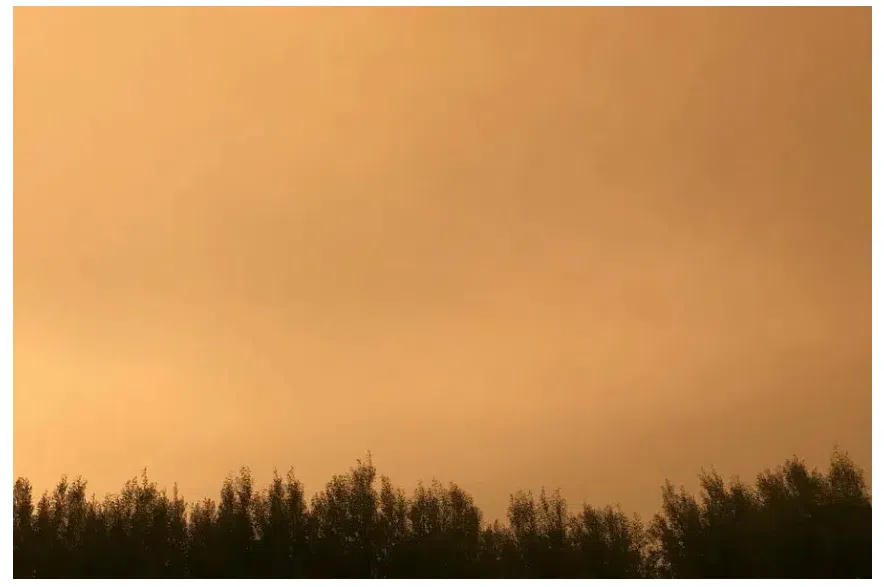The heat warnings were issued on Saturday afternoon and covered areas from just north of Humboldt, stretching as far north as the Northwest Territories. Air quality warnings were added for Saskatoon and Prince Albert as well as many northern areas on Sunday afternoon.
Environment Canada meteorologist Dan Fulton said on Saturday it would be hot in most places until Monday.
Read more:
- Saskatchewan water rescues prompt warning from RCMP
- La Ronge man charged with arson after allegedly starting major Weyakwin-area wildfire
- Mosquitoes are on the hunt. Here’s how to deal with their bites.
“Daytime highs are in the low 30s pretty much everywhere. And the heat warning criteria is a little easier to attain in northern Saskatchewan, so there are heat warnings out there, and it’s just as hot in the south,” said Fulton.
Afternoon humidex values for many areas had temperatures sitting between 34 C and 37 C.
Local officials in the northern village of Île-à-la-Crosse asked people to leave Canoe River Subdivision and campers to leave South Bay War Veterans Park on Saturday after the previously contained Muskeg and Trail fires spread because of weather conditions in the area.
Flames breached Highway 155 at Canoe River at one point. The highway re-opened Saturday.
“We are advising those in this area to vacate their properties for safety reasons,” the village said in a post on Facebook. No official evacuation has been ordered.
Northern areas like Île-à-la-Crosse and Buffalo Narrows should expect air quality of “very high risk” from wildfire smoke, meaning everyone should reduce or reschedule strenuous activities. People at risk should avoid outdoor activities altogether.
Areas like Saskatoon should expect to get air quality of “high risk,” meaning people at risk should reduce or reschedule strenuous activities outdoors. Children and seniors should “take it easy.” The general population should consider reducing or rescheduling strenuous activities if they start coughing or their throats become irritated.
The air quality warnings are expected to remain throughout Monday.
Environment Canada’s air quality index can be found here. You can take a look at the ratings in communities across your province or territory.
A rating of 1-3 is low risk, 4-6 is moderate risk, 7-10 is high risk and over 10 is very high risk.
The risk designations can change regularly in the same community, Environment Canada says, so it’s important to keep checking the air quality forecast.
The government agency lists the various health conditions that put you at higher risk at this website.
In southern Saskatchewan, Fulton said that the likelihood of heat warnings being issued was low.
“It’s just not quite high enough to meet the criteria there. So again, it’s certainly a warm day, and we’re looking at highs in the 30s, with humidex pushing it to the mid-30s,” said Fulton.
Fulton said humidity doesn’t do much to help in the fight against wildfires.
There were 44 active fires burning in Saskatchewan on Aug 31.
Saskatchewan Public Safety Agency (SPSA) said in a 3:30 p.m. report that three of those blazes were not contained, while another 31 of the fires were under ongoing assessment and firefighters were protecting values in three. Seven fires were considered contained.
Contained means suppression action is taking place and the fire is not expected to grow in size, ongoing assessment means the fire is being monitored regularly to assess risk to values in the area and not contained means suppression action is taking place but the fire is expected to grow in size, according to SPSA. Protecting values means a fire is active and action is focused on protecting things like cabins and infrastructure.
“Up north is actually pretty much the same as in the south. The higher the humidity, the better for firefighting, but counterbalancing that somewhat is that it’s also quite hot and sunny for most of the areas where the fires are burning. So that’s kind of a negative. So the humidity will help a bit, but the sun and the temperatures are negative factors there,” said Fulton.
Conditions are expected to moderate on Monday or Tuesday.
— with files from Roman Hayter
Read more:











